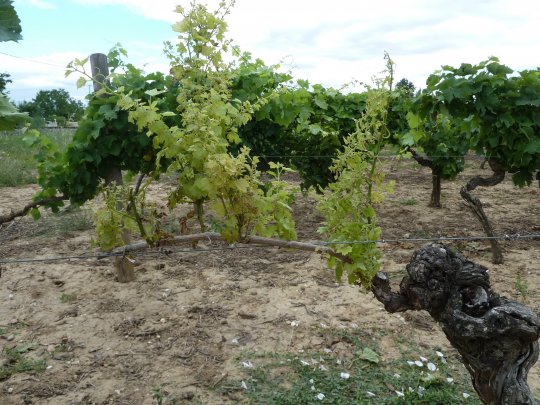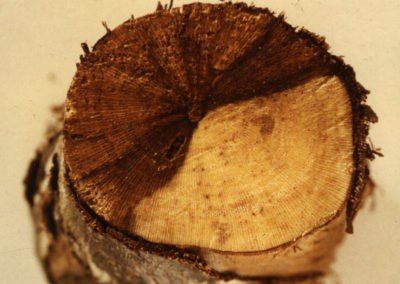Eutypiosis is a disease affecting mature vines that was identified in France in the late 1970s. It was certainly known long before that, being classified among the court-noués ("short-nodes"), a common term used to designate any disease that stunted vegetative growth. It occurs in all vineyards that receive more than 250 mm of rain.
2.4.2.d Eutypiosis
Eutypiosis results in the death of an arm. In the wood, it causes hard, brown sectorial necrosis with dark stripes. A vine that has died from this disease can be easily broken by giving a sharp kick to the base of the vine (core test).
On the parts of the vine without bark, it is possible to observe blackish bumpy areas corresponding to the preserved form of the fungus (perithecia).
Symptoms usually occur during rainy periods in the spring, and can disappear from one year to the next, even if the disease progresses during this time. The symptoms, appearing in plants at least 7 - 8 years old, are due to toxins (eutypine).
Some grape varieties such as Cabernet Sauvignon, Chasselas, Chenin, Cinsaut, Mauzac, Muscadelle, Négrette, Sauvignon and Ugni Blanc tend to display more eutypiosis symptoms. Others like Aligoté, Auxerrois, Grenache, Grolleau, Melon de Bourgogne, Merlot, Muscat à Petits Grains, Petit Verdot, Savagnin, Sémillon and Sylvaner, although affected by this disease, show fewer symptoms.
What is the biology of the fungus that causes eutypiosis?
Eutypa lata, the fungus responsible for eutypiosis, is preserved on dead wood as perithecia which contain the contaminating agents called ascospores. These are released after two to three hours of rain and dispersed by the wind. During the vine's resting phase, they are deposited on pruning wounds and migrate into the underlying tissues to a depth of at least two centimetres under the water's influence. They then germinate to give rise to mycelia which colonize the woody tissue to form brown sectorial necrosis.
Extract from Vigne Vin Occitanie
Are there any preventive measures?
Prophylactic methods are the same as for contamination by Esca


